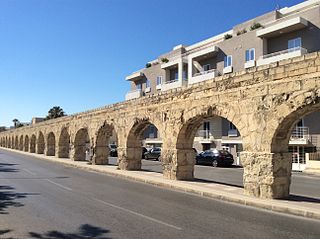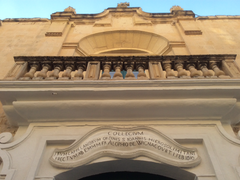
Rabat is a town in the Western Region of Malta, with a population of 11,497 as of March 2014. It adjoins the ancient capital city of Mdina, and a north-western area formed part of the Roman city of Melite until its medieval retrenchment.

Fra Alof de Wignacourt was a French nobleman who was the 54th Grand Master of the Order of St. John of Jerusalem from 10 February 1601 to his death in 1622. Unlike a number of the other Grand Masters, he was popular with the Maltese people. Wignacourt is mostly remembered for the construction of the Wignacourt Aqueduct as well as a series of coastal towers which also bear his name.

St John's Co-Cathedral is a Catholic co-cathedral in Valletta, Malta, dedicated to Saint John the Baptist. It was built by the Order of St. John between 1573 and 1578, having been commissioned by Grand Master Jean de la Cassière as the Conventual Church of Saint John.

Santa Venera is a town in the Southern Region of Malta, with a population of 8,834 (2021). It is located between the towns of Birkirkara and Ħamrun, and also borders Qormi and Msida.

Wignacourt Tower, also known as Saint Paul's Bay Tower, is a bastioned watchtower in St. Paul's Bay, Malta. It was the first of six Wignacourt towers to be built, and the first stone was laid on 10 February 1610. It replaced the role of Ta' Tabibu farmhouse which was previously known as Dejma Tower. An artillery battery was added a century later in 1715. Today the tower is a museum of fortifications around the Maltese Islands.

Maltese architecture has its origins in prehistory, and some of the oldest free-standing structures on Earth – a series of megalithic temples – can be found on Malta. The islands were colonized by the Phoenicians and later the Romans, who established the cities of Melite and Gaulos. Although these were substantial settlements and are known to have had numerous temples, churches and palaces, few remains have survived apart from some architectural fragments.

The Palace Armoury is an arms collection housed at the Grandmaster's Palace in Valletta, Malta. It was the main armoury of the Order of St. John in the 17th and 18th centuries, and as such it was the last arsenal established by a crusader military order. Although today only a part of the original armoury still survives, it is still one of the world's largest collections of arms and armour still housed in its original building. The Palace Armoury has been open to the public as a museum since 1860.

St. George's Basilica or the Basilica and Collegiate Parish Church of Saint George, also simply known as San Ġorġ in Maltese, is a historic Baroque church situated in the middle of Gozo, the second largest island in the Maltese archipelago, and is surrounded by a maze of old narrow streets and alleys. The church had been rebuilt numerous times during the Middle Ages. Today's basilica was built between 1672 and 1678.

Santa Maria delle Grazie Tower, also known as Delle Grazie Tower, Madonna delle Gratie Tower or Blata Bajda Tower, was a watchtower in what is now Xgħajra, Malta. It was constructed in 1620, and was the last of six Wignacourt towers to be built. The tower was demolished in the late 19th century by the British military.

The Metropolitan Cathedral of Saint Paul, commonly known as St Paul's Cathedral or the Mdina Cathedral, is a Catholic cathedral in Mdina, Malta, dedicated to St. Paul the Apostle. The cathedral was founded in the 12th century, and according to tradition it stands on the site where Roman governor Publius met St. Paul following his shipwreck on Malta. The original cathedral was severely damaged in the 1693 Sicily earthquake, so it was dismantled and rebuilt in the Baroque style to a design of the Maltese architect Lorenzo Gafà between 1696 and 1705. The cathedral is regarded as Gafà's masterpiece.

Natale Masuccio, also known as Mesuccio or Tomasucci, was an Italian architect and Jesuit. He is regarded as one of the most important architects in Sicily during the transition between Mannerism and Baroque.

Fleur-de-Lys is a suburb that forms part of Birkirkara, and is also considered a suburb of Santa Venera and Qormi. It lies approximately 5 kilometers from Malta's capital, Valletta. The population of Fleur-de-Lys is about 2,200 people and the area is very small.

The Wignacourt Aqueduct is a 17th-century aqueduct in Malta, which was built by the Order of Saint John to carry water from springs in Dingli and Rabat to the newly built capital city Valletta. The aqueduct carried water through underground pipes and over arched viaducts across depressions in the ground.

The Basilica of St Paul is a Roman Catholic Parish church located in Rabat, Malta.

The Church of Our Lady of Liesse is a church in Valletta, Malta. The church was built in 1740 on the site of a 17th-century church. The cupola was built to the design of the Maltese architect Francesco Zammit. The church is located on the waterfront of the Grand Harbour, close to Lascaris Battery and the site of the fish market. It is especially venerated by the people of the port area.

Casa Cosmana Navarra is a 17th-century aristocratic townhouse in Rabat, Malta. The building belonged to Cosmana Navarra (1600-1687), for whom it is named until date, who was the main benefactress of the rebuilding of the Rabat parish church of St. Paul. The house is found in front of the parish church opposite the Wignacourt Museum. Most of the building was converted into a restaurant.

Melite or Melita (Latin) was an ancient city located on the site of present-day Mdina and Rabat, Malta. It started out as a Bronze Age settlement, which developed into a city called Ann under the Phoenicians and became the administrative centre of the island. The city fell to the Roman Republic in 218 BC, and it remained part of the Roman and later the Byzantine Empire until 870 AD, when it was captured and destroyed by the Aghlabids. The city was then rebuilt and renamed Medina, giving rise to the present name Mdina. It remained Malta's capital city until 1530.
Stefano Erardi (1630–1716) was a Maltese painter whose works may be found in many churches around the Maltese Islands. His style has been described as either late Mannerist or Baroque.

Fra Pietro Erardi (1644–1727) was a Maltese chaplain and painter. He was a cleric and became a chaplain of obedience of the Order of St. John in 1669. He joined the Wignacourt College in Rabat in 1683 and remained there until his death.

Francesco Vincenzo Zahra was a Maltese painter who mainly painted religious works in the Neapolitan Baroque style. His works may be found in many churches around the Maltese Islands, as well as in some private collections and museums. He is considered to be the greatest painter from 18th-century Malta.


























